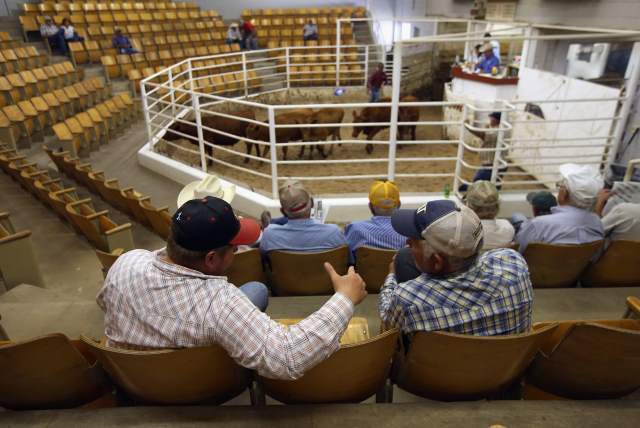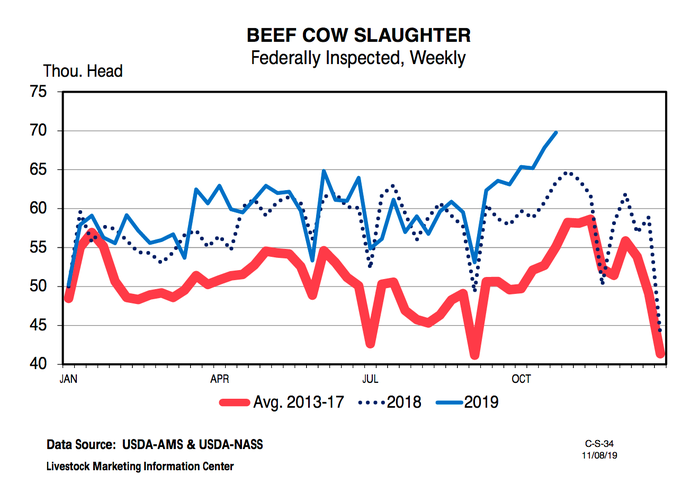The cows, they are a’coming
A confluence of factors are causing beef cow slaughter to take a significant uptick.

Spend time in just about any livestock auction, especially in the Northern Plains and Midwest, and I suspect you’ll hear plenty of stories about just how bad a year it’s been. If you live in a broad swath of that country, I suspect you have plenty of your own to tell.
I was in Napoleon Livestock, the sale barn in Napoleon, N.D., visiting with Ray Erbele, one of the owners, along with Jim and Paul Bitz, two brothers who own the auction along with their dad, George, and Erbele. It was the evening before their regular Thursday sale and they were expecting 4,500 to 5,000 head for the sale.
That’s about average for this time of year, Ray told me. What’s different this year is the higher number of cows they’re selling, and have been since September. It’s been an oddly different year, Ray said. Plenty of rain and plenty of grass and hay, and people are selling cows because they’re short of feed.
That’s because most of the hay isn’t very good. In fact, it’s not very good at all.
Visiting with some of the folks who delivered cattle that Wednesday evening, I heard of hay fields so deep in water that only a couple of feet of the top of the round bales poked above the waves. Another rancher was in much better shape. He stacked and stored his hay immediately after he baled and thought he was ready for winter.
I suspect he’s in the minority.
According to the Nov. 13 Daily Livestock Report (DLR), “Beef cow slaughter soared to the highest week since May of 2013, reaching 69,700 head. Beef cow slaughter has been above a year ago every week since late August, and posted double digit increases over the last weeks. The latest week of data (10/26/2019) was 9.7% higher than a year ago. These high cull rates have tipped the ratio to over 50% of the cow slaughter mix. Beef cows have made up over 50% of the slaughter mix for the last five weeks.”

Slaughter cows are also coming in at lower weights compared to last year, DLR economists report. Year-to-date the weekly average dressed weights of slaughter cows have fallen by 6 pounds this year, which is likely contributing to higher Fresh 90% lean prices over the better part of this year.
“Fresh 90% lean prices spiked to $230 per cwt last week, the highest price in over a year. Dairy cow slaughter numbers have been restrained in the second half of 2019 compared to the first half. Year to date those figures are up 3% from last year. Imports from Australia and New Zealand were down year-over-year in September, which has also helped support lean beef prices.”
In the Nov. 11 newsletter In the Cattle Markets from the Livestock Marketing Information Center, Elliott Dennis, livestock marketing economist at the University of Nebraska Lincoln, took a look at how the Tyson beef plant fire affected cow-calf producers.
“The weekly USDA-AMS Cow Slaughter Under Federal Inspection (Cow Slaughter) report can provide the direction of cow-calf producer response. This report suggests that there is a large beef cow sell-off occurring since the week of Sept. 14 with significant regional differences,” he writes.
“There is a clear uptick between beef cow slaughter in 2018 and 2019 beginning in week 37 and well above the three-year average. Approximately 28% of the increase in beef cow slaughter came from regions with include Nebraska, Texas and Kansas; 32% from Idaho, Oregon and Washington; and 16% from the Southeast.”
The fire at the Holcomb, Kan., plant occurred on August 9, 2019, the 32nd week of the year. The Holcomb fire has surely impacted some producer’s decision to remain in the business, he said.
“However, this rise in beef cow slaughter was partially driven by other factors other than the Holcomb fire. Several reasons include: 1) imported 90% lean beef prices are skyrocketing, largely driven by Chinese demand, but has pulled the domestic market along with it (Lean Beef), 2) wet spring and summer seasons has damaged hay tightening available hay supplies going into winter (Hay Stocks), and 3) while futures markets have rebounded from the fire, local cash markets have been slower to respond (Feeder Cash Prices).
“In the short term, this reduction in beef cows affects the number of calves born next year and feeder cattle available to enter feedlots. In the long term, it could ultimately signal that the industry is beginning to enter a contractionary phase of the cattle cycle. Monitoring these trends the remainder of the year will reveal producer preferences.”
Getting back to North Dakota, it's very little corn has been harvested in the area. While visiting the DeWitz outfit north of Tappen, N.D., they said the moisture is running 25% to 30% in their corn.
They harvested some to use in the ration for their 500-head custom backgrounding feedyard but will wait to cut the rest. “It will be an all winter deal,” said Jerry, the Dewiitz outfit’s patriarch.
In short, time and lots of propane will be the recipe for this year’s harvest. And folks at the Napoleon auction speculated that there will still be corn to cut next spring, not cut at all. It will be a deal where the planter will follow the combine, one rancher told me.
There is no easy way to describe the year that was 2019. But this is a “next year” business. “And next year will be better,” Jerry said with a wry smile.
About the Author(s)
You May Also Like


.png?width=300&auto=webp&quality=80&disable=upscale)
